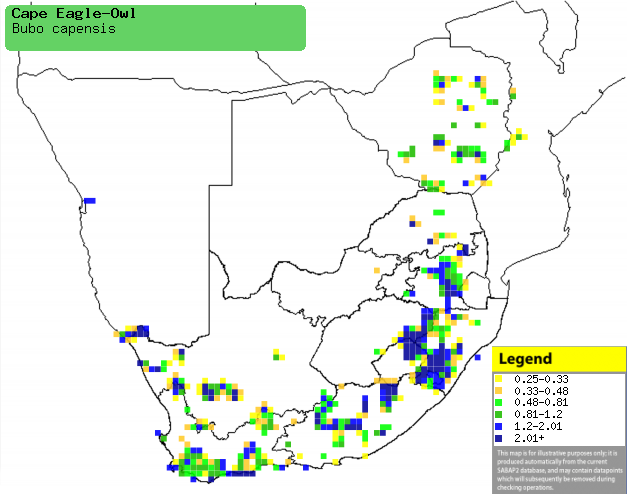|
Bubo capensis (Cape eagle-owl)
Kaapse ooruil [Afrikaans]; isiKhovampondo (also applied to
Spotted eagle owl) [Zulu]; Khuhunu, Phikuphiku, Xikhova [Tsonga]; Kaapse oehoe
[Dutch]; Grand-duc du Cap [French]; Kapuhu [German]; Bufo do Cabo [Portuguese]
Life
> Eukaryotes >
Opisthokonta
> Metazoa (animals) >
Bilateria >
Deuterostomia > Chordata >
Craniata > Vertebrata (vertebrates) > Gnathostomata (jawed
vertebrates) > Teleostomi (teleost fish) > Osteichthyes (bony fish) > Class:
Sarcopterygii (lobe-finned
fish) > Stegocephalia (terrestrial
vertebrates) > Tetrapoda
(four-legged vertebrates) > Reptiliomorpha > Amniota >
Reptilia (reptiles) >
Romeriida > Diapsida > Archosauromorpha > Archosauria >
Dinosauria
(dinosaurs) > Saurischia > Theropoda (bipedal predatory dinosaurs) >
Coelurosauria > Maniraptora > Aves
(birds) > Order: Strigiformes
> Family: Strigidae
The Cape eagle-owl can be seen in many parts of southern
Africa, but nowhere is it common. It lives in rocky,
sometimes mountainous areas, in various vegetation types. Most of its diet
consists of mammals, but it also feeds on birds and invertebrates. Amazingly,
it can carry prey that is 4,5 kg, or 4 times its weight! It nests in
scrapes in the ground, often on ledges or between cliffs. It lays 1-3 eggs, and
incubation lasts for 34-38 days, the female doing most of it, with the male
sometimes taking over while the female feeds. After fledging, juveniles stay
dependent on their parents for 2-3 months, before leaving completely.
Distribution and habitat
It has an extremely fragmented range, with populations in
Ethiopia, Kenya and southern Africa;
there are no places where you can see it easily. Within southern Africa it is
scarce in southern Namibia, Zimbabwe, western Mozambique, Lesotho and South
Africa, from Limpopo Province south to Kwazulu-Natal and west to the Northern
and Western Cape. It is restricted to mountainous areas with cliffs, outcrops
and gorges, and can live as high as 2500m above sea level. Habitat preferences
vary from region to region, favouring mesic fynbos in the Western Cape, miombo woodland
in Zimbabwe, grassland and bushveld in Gauteng and Mpumalanga, and semi-desert
scrub in Namibia.
|
 |
|
Distribution of Cape eagle-owl in southern Africa,
based on statistical smoothing of the records from first SA Bird Atlas
Project (©
Animal Demography unit, University of
Cape Town; smoothing by Birgit Erni and Francesca Little). Colours range
from dark blue (most common) through to yellow (least common).
See here for the latest distribution
from the SABAP2. |
Food
Mainly eats mammals, supplemented with birds, reptiles and
invertebrates. It hunts at night, searching for prey on low
perches. Once prey has been located, it swoops silently down, grabbing the prey
with its strong talons. Amazingly, it is capable of carrying prey weighing 4.5
kg, four times its body weight of 1.0-1.2 kg! The following species have been recorded in
its diet:
- Vertebrates
- Invertebrates
Breeding
- Nests in a scrape in the ground, often on ledges,
hidden by trees or rocks, in cliff recesses or regularly near streams or
rivers. The female often lies in the scrape for days before laying her eggs.
It sometimes uses the same nest site repeatedly, but not in consecutive years.
- Egg-laying season is from May-July in eastern South Africa and Zimbabwe,
from August-September in the Eastern Cape and from June-August in the Western Cape.
- It lays 1-3 eggs, which are incubated mainly by the female for about
34-38 days. The male spends most of his time providing her with food,
although he may incubate occasionally so that the female can hunt.
- Once the chicks are born the male still does most of the hunting, but
the female always feeds the prey to the brood. The chicks leave the nest at
about 45 days old, but still remain in the vicinity of the nest, where they
are still fed by
both their parents. They become fully independent 2-3 months
after fledging.
Threats
Not threatened, but potentially impacted by overgrazing and
fires.
References
-
Hockey PAR, Dean WRJ and Ryan PG (eds) 2005. Roberts
- Birds of southern Africa, VIIth ed. The Trustees of the John Voelcker
Bird Book Fund, Cape Town.
|
